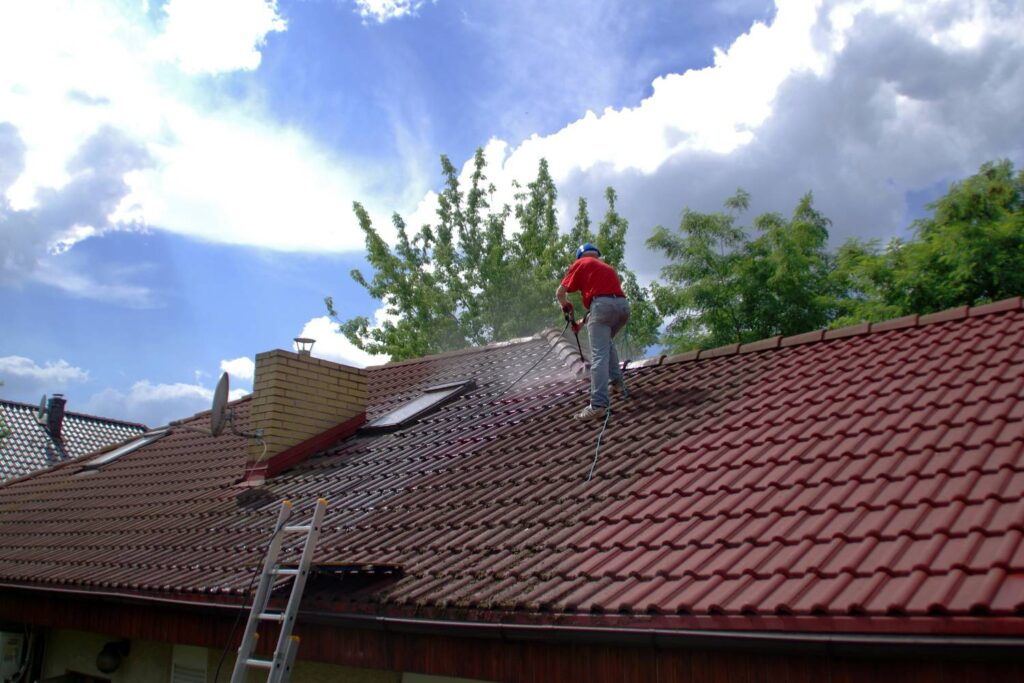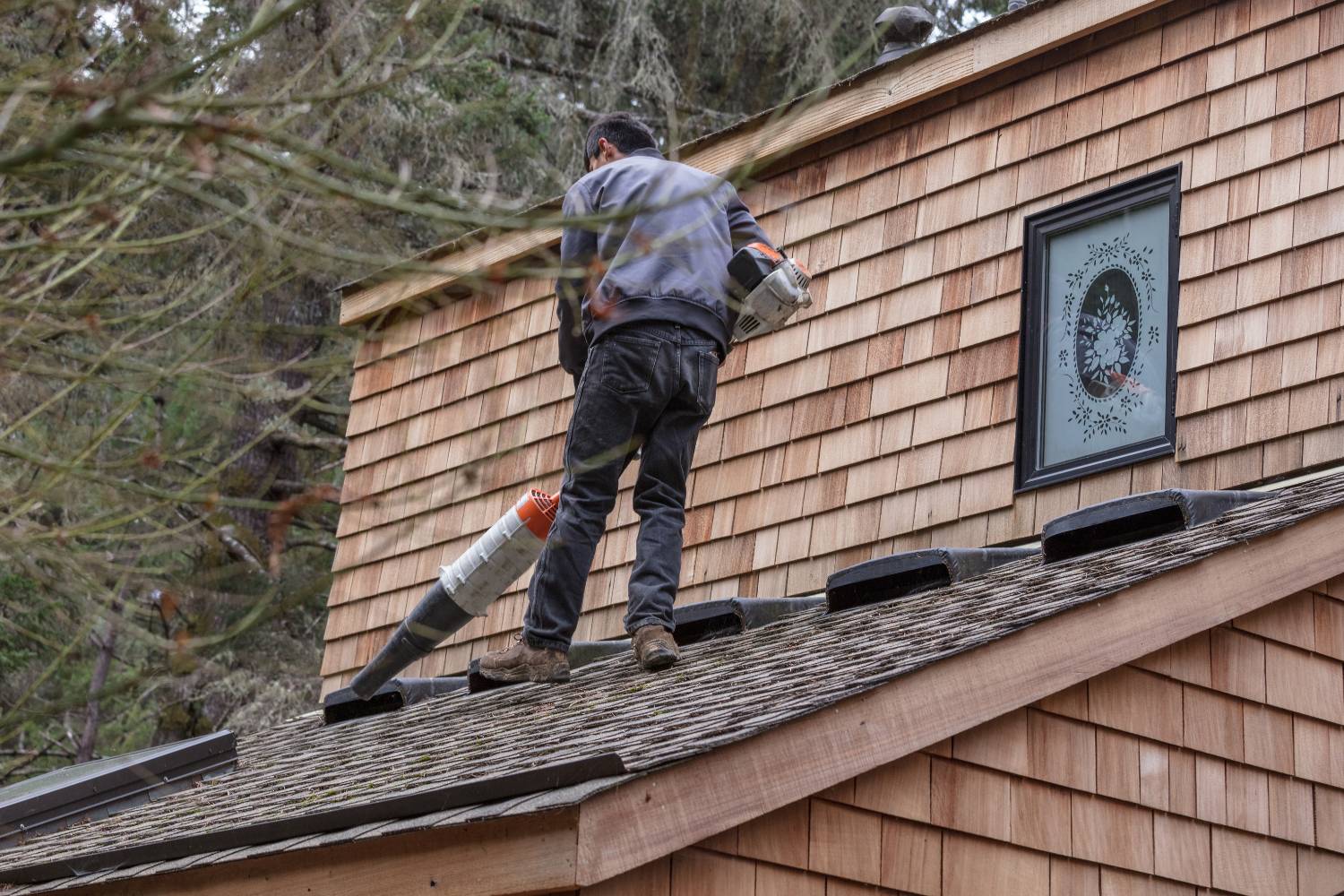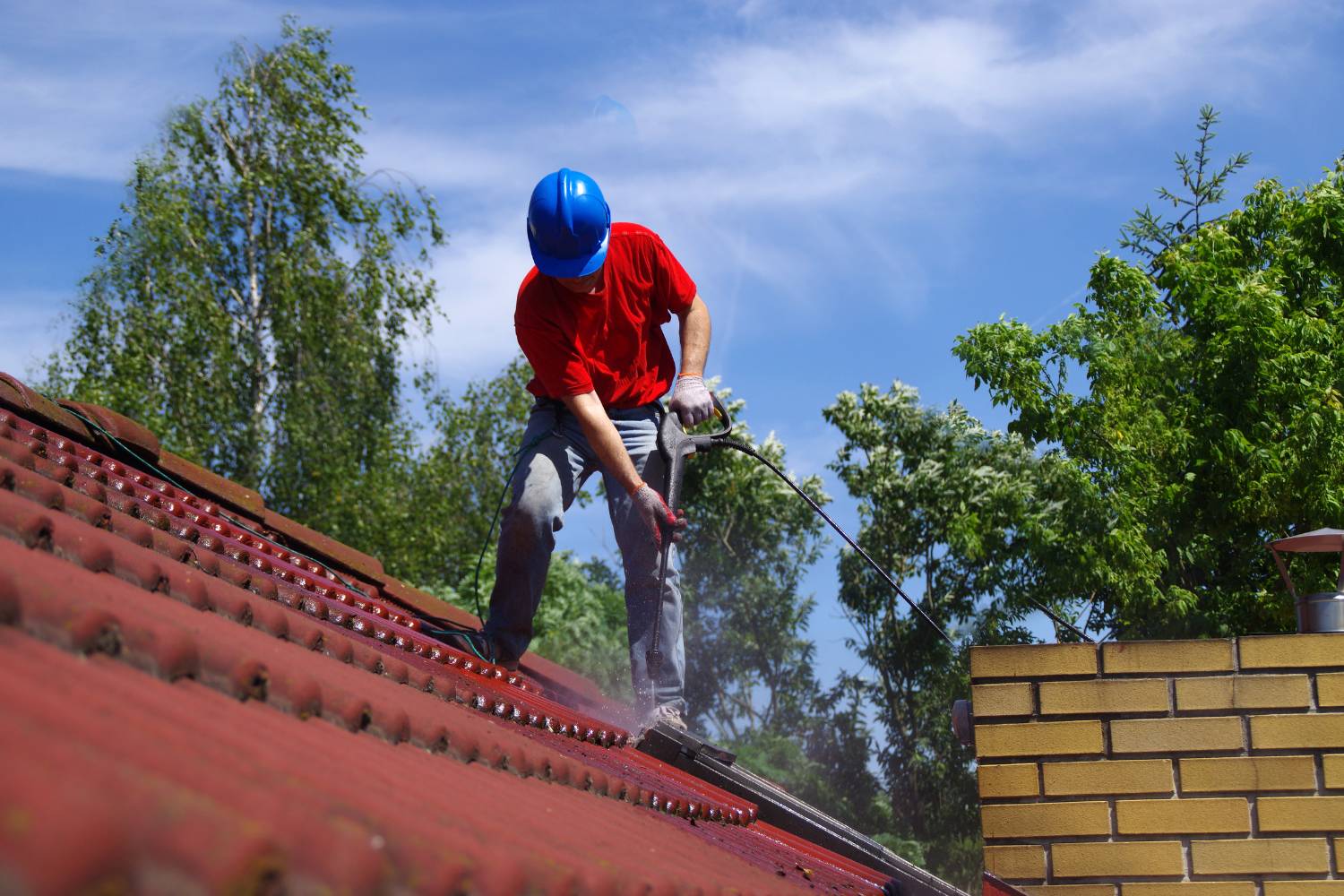Cleaning your roof is an essential task for maintaining your home's integrity and appearance. Using the right tools and techniques can prevent damage and extend the lifespan of your roof.
This guide offers a comprehensive overview of the basic tools needed for roof cleaning, ensuring you have everything necessary to perform the task safely and effectively.
What Basic Tools Do You Need For Roof Cleaning?
Cleaning your roof is essential for maintaining the integrity and appearance of your home. Using the right tools and techniques can prevent damage and extend the lifespan of your roof. Here is a comprehensive guide on the basic tools needed for roof cleaning, compiled and made unique from various sources.
Ladder
Ensuring you have a sturdy ladder that reaches your roof comfortably is crucial. It should have non-skid feet to prevent slipping, providing a stable platform for accessing your roof safely.
Non-Skid Shoes
Rubber-soled shoes are recommended for better grip and safety while working on the roof. It is essential to avoid walking on a wet roof to reduce the risk of slipping and falling, which can lead to severe injuries.
Garden Hose
An extra-long garden hose with a spray nozzle attachment is ideal for roof cleaning. This tool is necessary for rinsing off dirt and cleaning solutions effectively. It is important to use low pressure to avoid forcing water beneath the shingles, which could cause damage and leaks.
Cleaning Solutions
For an effective bleach solution, mix 4 gallons of hot water, 1 gallon of bleach, and 1 cup of Trisodium Phosphate (TSP) in a bucket. This mixture is potent for removing algae and moss. Alternatively, eco-friendly cleaning solutions are recommended for removing organic growth such as algae, moss, and lichen. These solutions are safe for the environment and your shingles, ensuring thorough cleaning without harmful effects.
Garden Sprayer
A basic garden sprayer is effective for applying the cleaning solution to your roof. It ensures even coverage, allowing the solution to work efficiently. It is important to keep the solution wet for about 15 minutes to maximise its cleaning potential.
Soft Bristle Brush
A soft-bristle brush is a gentle yet effective tool for removing loose debris, leaves, and pine needles without damaging the shingles. It is essential to use a brush with non-abrasive bristles to avoid scratching the roof surface.
Safety Gear
Using appropriate safety gear is vital when cleaning your roof. A safety harness can prevent falls, while gloves and protective eyewear protect your hands and eyes from harsh chemicals. Additionally, always wear non-slip shoes to ensure a good grip on the roof surface.
Bucket
A large bucket is necessary for mixing and carrying the cleaning solution. Ensure it is spacious enough to hold all the components of the cleaning mixture, allowing for easy transportation and application.
What Safety Equipment Should You Use For Roof Cleaning?
When it comes to roof cleaning, safety is paramount. Working at heights exposes you to various risks, and using the proper safety equipment can significantly reduce these hazards. Below is a comprehensive guide to the essential safety gear needed for roof cleaning, ensuring you stay safe while performing this necessary maintenance task.
Personal Protective Equipment (PPE)
Personal protective equipment (PPE) is the first line of defence for anyone working on a roof. A hard helmet is essential to protect your head from falling debris. Additionally, a safety harness is vital as it arrests falls and keeps you secure on the roof.
Wearing slip-resistant work boots provides better traction and stability, preventing slips and falls. Gloves are also important as they protect your hands from sharp edges and rough surfaces. Finally, a fall arrest system, which includes a harness and an anchorage point, ensures that any fall is arrested quickly, reducing the risk of serious injury.
Fall Restraint Systems
Using fall restraint systems is crucial when working on steep or slippery roofs. A roof safety harness should always be worn, and it should be connected to secure lanyards. These lanyards, such as sling lanyards and positioning lanyards, are essential for maintaining safety while performing various tasks.
It is equally important to have properly installed anchorage points. These points, installed by a qualified person, must be capable of absorbing high energy loads to ensure that in the event of a fall, the chances of injury are minimised.
Safety Procedures For Roof Cleaning
Before starting any roof cleaning project, it is essential to conduct a thorough risk assessment to identify potential hazards. Begin the cleaning process by removing large areas of moss with a roof scraper. This initial step ensures that the roof is free from loose debris that could interfere with the cleaning process.
After scraping, use soft washing techniques to apply cleaning solutions that eradicate organic matter and contaminants. Following the cleaning, apply a biocide treatment to kill bacteria and fungi, which helps prevent future growth and prolongs the life of the roof. This comprehensive approach not only ensures a clean roof but also maintains its structural integrity over time.
Essential Roof Cleaning Equipment
Several pieces of equipment are indispensable for safe and effective roof cleaning. A roof scraper is necessary for removing moss and debris, while telescopic poles allow you to reach all areas of the roof without needing to climb. Biocide is used to kill and prevent the growth of harmful organisms, ensuring the roof remains clean and healthy.
Rope protectors are essential to protect ropes from abrasion on sharp edges, maintaining their integrity and safety. Roof brackets provide stable footing and prevent tools from falling, making the workspace safer. Lastly, carabiners are used to secure lanyards and other equipment, ensuring everything remains in place during the cleaning process.
What Are The Best Brushes And Scrapers For Roof Cleaning?
Cleaning a roof is a vital maintenance task that helps to extend its lifespan and maintain its appearance. The right tools make this job easier and more effective. Here, we explore some of the best brushes and scrapers for roof cleaning, drawing on information from various sources to provide a comprehensive guide.
Wire Brushes For Roof Cleaning
Wire brushes are highly effective for removing moss and other debris from roofs. Their stiff bristles can reach into the edges and seams of shingles, where moss tends to accumulate. Unlike pressure washers, wire brushes do not remove as many roof granules, which helps preserve the integrity of the shingles. To use a wire brush effectively, start by scrubbing the moss loose and then use a leaf blower to clear away the debris. This method is gentle yet effective and reduces the risk of damaging the roof.
Roof Scraper Heads, Blades, And Brushes
Roof scrapers are another essential tool for roof cleaning, particularly for removing moss. These tools come with various attachments, such as blades and brushes, which can be adjusted based on the level of cleaning required.
For example, Gutter Vacuum Systems offers innovative scraper heads that can be equipped with different numbers of blades, from a single blade to 18 blades. These scrapers are designed to tackle even the most stubborn moss and debris efficiently. Additionally, they offer brush attachments for more delicate cleaning tasks, ensuring versatility in roof maintenance.
Types Of Roof Scraper Heads And Attachments
- Single Blade Scraper Head: Ideal for smaller areas or less severe moss growth.
- Multi-Blade Scraper Head: Equipped with up to 18 blades, these are suitable for extensive cleaning and large roof areas.
- Brush Attachments: Available in various bristle types, including steel and polypropylene, these are used for softer cleaning tasks without damaging roof tiles.
Tips For Using Brushes And Scrapers Safely
When using brushes and scrapers, it's important to prioritise safety to prevent accidents and damage to the roof. Here are some essential tips:
- Always Use Safety Gear: Wear non-slip shoes, gloves, and eye protection.
- Start from the Top: Begin cleaning from the top of the roof and work your way down to avoid pushing debris under the shingles.
- Avoid Excessive Pressure: Use gentle scrubbing motions to prevent damage to the shingles or roof tiles.
- Regular Maintenance: Regularly inspect and maintain your brushes and scrapers to ensure they remain effective and safe to use.
Can You Use A Pressure Washer For Roof Cleaning?
Pressure washing might seem like an efficient way to clean your roof, but it can actually cause more harm than good. While using powerful jets of water to blast away dirt, mould, and mildew may seem like the right approach, the reality is that this method can lead to significant structural and electrical damage. Here’s why you should avoid pressure washing your roof and consider safer alternatives instead.
Damage To Your Roof
Roofs are built to withstand elements like rain, snow, and falling debris, but they are not designed to handle the force of highly pressurised water. Using a pressure washer on your roof can cause the adhesive bonds between roofing materials to break, damaging the underlying fabric that protects your home’s interior.
This can result in cracks or breaks in ceramic, cement, or slate tiles. For clay or shingle roofs, high-pressure water can cause leaks, allowing water to penetrate into your home. Features such as vents, skylights, and solar panels can also be compromised, leading to further leaks and water damage.
Electrical Hazards
One of the significant risks of pressure washing your roof involves electrical hazards. Water can easily find its way into electrical service panels, overhead wires, and outlets on the exterior of your home. This not only increases the risk of electrocution and electric shock but can also cause serious damage to your home’s electrical system. The potential for such dangerous situations makes pressure washing a high-risk activity that can lead to costly repairs and safety hazards.
Climbing Hazards
Walking around on a wet roof is inherently dangerous due to the risk of slipping and falling. The dangers are compounded when you introduce a pressure washer into the mix. Handling a hose on a wet, slippery surface while trying to manage the machine can result in severe injuries. Even if the pressure washer remains on the ground, constantly moving around to adjust its position involves repeatedly climbing up and down a ladder, increasing the risk of falls.
Alternatives To Pressure Washing
Given the risks associated with pressure washing, a safer alternative is to use a soft wash method. Soft washing involves using low-pressure water combined with specialised cleaning solutions to safely remove debris, mould, and mildew without causing damage to your roof. This method is effective and preserves the integrity of your roof.
Conclusion
Roof cleaning is essential for maintaining your home's integrity and appearance. Using the right tools, such as sturdy ladders, non-skid shoes, and soft-bristle brushes, alongside safety equipment like personal protective gear and fall restraint systems, ensures effective and safe cleaning. While pressure washing can damage your roof, safer alternatives like soft washing are recommended. By following these guidelines, you can extend your roof's lifespan and keep it in excellent condition.
Frequently Asked Questions
To start cleaning your roof, you will need a sturdy ladder, a garden hose with a spray nozzle, a bucket, and basic cleaning solutions. Additionally, having safety gear such as gloves, safety goggles, and non-slip shoes is essential to ensure your safety while working on the roof.
While a pressure washer can be effective for cleaning certain types of roofs, it is not always necessary and can sometimes cause damage if not used correctly. It's best to use a low-pressure setting and appropriate cleaning solutions to avoid damaging the roofing materials. For delicate roofs, consider using a garden hose with a spray nozzle or a roof cleaning wand instead.
The type of brush you use depends on your roofing material. Soft-bristle brushes are ideal for delicate surfaces like asphalt shingles, while stiff-bristle brushes can be used for more durable materials like concrete tiles. Always ensure the brush is compatible with your roof type to avoid causing damage.
Essential safety equipment for roof cleaning includes a safety harness, a helmet, and non-slip shoes. Additionally, using a sturdy ladder with proper footing and securing it properly is crucial. Gloves and safety goggles are also important to protect your hands and eyes from debris and cleaning solutions.
Yes, it's a good idea to clean your gutters while you're cleaning your roof. You will need a gutter scoop, a hose attachment, and possibly a gutter cleaning wand to remove debris efficiently. Keeping your gutters clean is important for preventing water damage and ensuring proper drainage from your roof.


